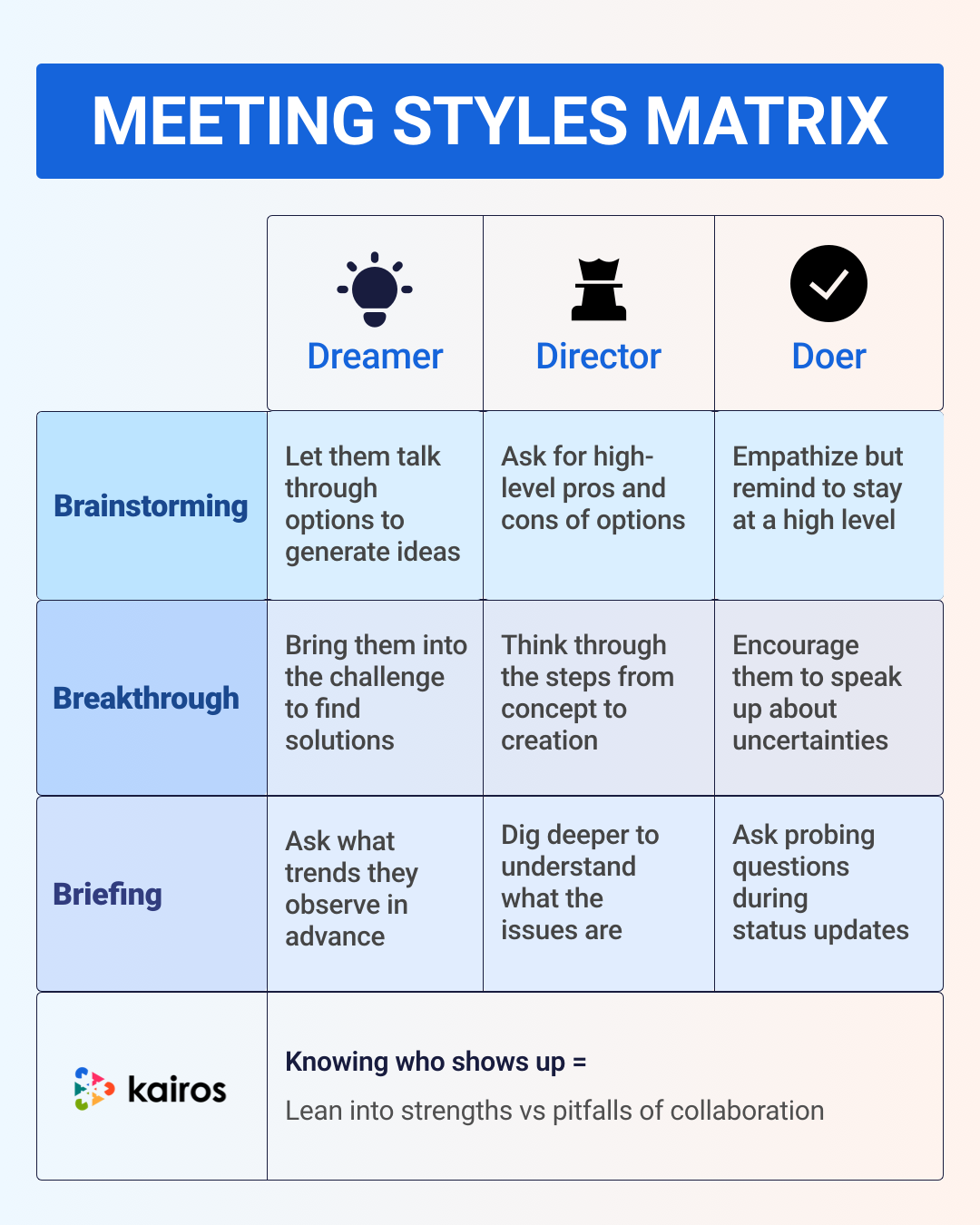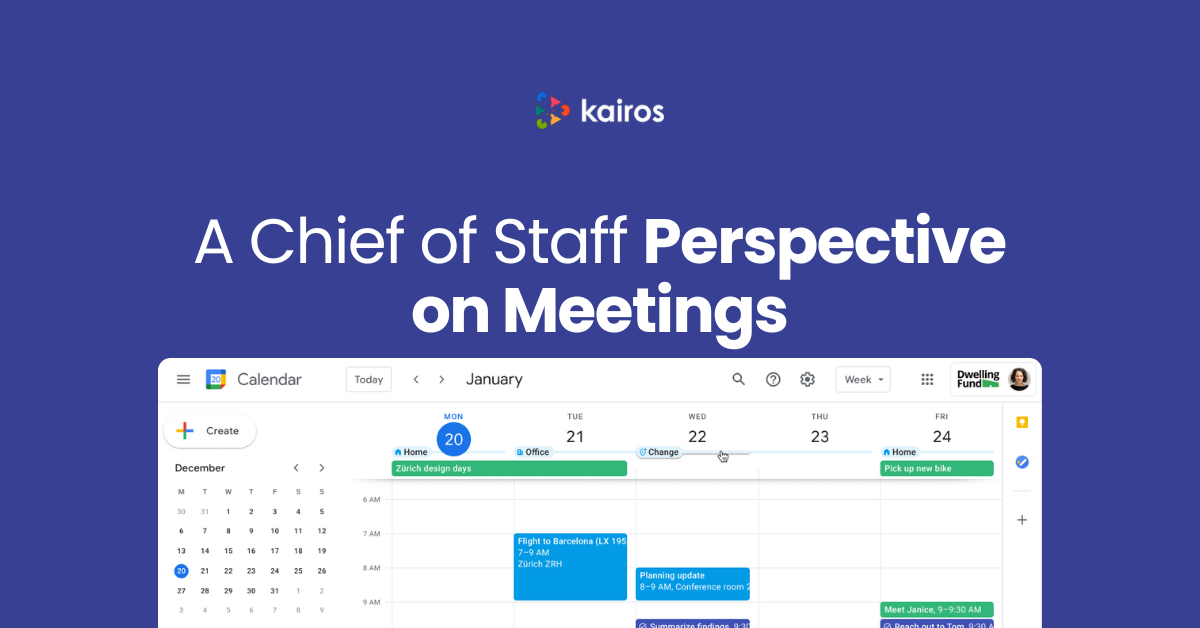The Right Mindset for the Right Meeting
What if every meeting didn’t have to feel the same? What if the endless tangents, the debates that spiral out of control, and the frustration you feel when you’re just trying to get to a decision could be managed by setting the right mindset before the meeting even begins?
Tom's Meeting Madness
Let me start by introducing you to Tom. He’s a practical and fast-moving individual who’s known for saying things like: "no time like the present," and "if you're waiting for perfect, you'll be waiting forever." As you can probably guess, his singular metric for success is how many things are checked off his to-do list before the end of the day.
For the last three months poor Tom has felt like he was trapped in a bad rerun of the Twilight Zone. As his firm worked through the conceptual design stage every meeting dragged him through the same half-decisions and recycled conversations. For Tom, who loves action, these pie-in-the-sky meetings were endless ideas with no discernable steps toward progress.
This next meeting was different. His firm completed the conceptual stage and moved into detailed design. Tom had planned this meeting out. He was going to start with a recap of previous decisions, briefly outline the design plan for this next phase, and finish by efficiently listing key decisions that the client will need to make. He figured the meeting would wrap up early, and he could get back to “real work” before lunch. However, as Mike Tyson famously said, “Everyone has a plan until they get punched in the mouth.”
Tom’s sucker punch was delivered by the client’s technical advisor hypothesizing different options for the project, practically undoing all the decisions Tom worked so hard to nail down. With his level of frustration rising he started raising objections. Cost implications. Schedule delays. Tom tried to explain all of this, but every objection was met with someone’s grand new idea.
Sadly, this isn’t just an issue for Tom. A recent study found that meetings are ineffective 72% of the time.1 Another study found that companies waste an estimated $25,000 per employee per year on ineffective meetings.2 With so much to lose, we must make meetings more effective. The fix starts with the people who attend the meetings.
Working Styles – An Abridged Version for Meeting Managers
People are complicated, and trying to understand our behaviors and their underlying psychology can feel overwhelming. Thankfully we don’t need to be psychologists to run a meeting; but we do need a simple way of understanding how people approach their work.
Many business authors and consultants have developed models with simple language to describe working styles within organizations. Les McKeown’s Predictable Success, Patrick Lencioni’s Working Genius, EOS Worldwide, and many other models are all very useful. If we boil it all down, we can think of people’s working styles in three broad categories: Dreamers, Directors, and Doers.
Dreamers: They think about the big picture, cast a vision. They imagine what doesn’t yet exist.
Directors: The planners. They figure out how to bridge vision with reality.
Doers: They get it done. Their focus on execution propels the project forward.
Generally, people can do a bit of all three, but they habitually default to one preferred style. Every meeting you run will have a mix of these three styles. Knowing who is showing up will help you navigate the meeting to keep it on course.
The Personalities Beneath the Styles
Layered on top of how people approach work (whether they are Dreamers, Directors, or Doers), are their personalities. In psychology, they often refer to the "Big Five" general categories and assess whether people have high or low: neuroticism, extraversion, openness to experience, agreeableness, and conscientiousness. Though we won’t discuss personalities in detail, you need to know that someone’s personality will influence how their working style is perceived.
Imagine two identical meetings, except that in one meeting the Director is extroverted and disagreeable, and in the other meeting the Director is introverted and agreeable. In the first meeting, the Director will have no problem voicing their opinions on the Dreamer’s ideas, and they may accidentally take over the meeting by jumping straight into planning before the new idea is fully formed. In the other meeting, with the agreeable introvert, this Director could stay quiet even after realizing a critical flaw in the Dreamer’s idea, or if they do speak up, they are so gentle in their phrasing that nobody else sees the comment for the giant red flag that it is.
Being aware of working styles and personalities will empower you to call on people in a way that draws out their strengths. In the case of our agreeable introvert, you may need to call on them directly and in a way that shows their critique as something beneficial and desired. For example, you could say:
"Taylor, I know you've been following our discussion on Casey's idea, and you are really good at spotting where something like this may go wrong. We all love Casey and the general direction of this idea, and we want to make sure that we as a team are successful. What roadblocks or issues do you think might exist here?"
In this example your question:
- Calls on Taylor directly: This ensures they know it is their turn to speak, which helps an introvert feel invited rather than pressured.
- Frames the question as helpful to Casey: By showing the critique would support Casey, you shift it away from confrontation. This helps an agreeable personality feel safe to give constructive feedback.
- Reaffirms Taylor’s strength: By highlighting their skill, you acknowledge the unique value Taylor brings to the team. This empowers Taylor personally and strengthens team trust by showing that sharing feedback isn’t just safe, it’s actively encouraged.
With a basic understanding of how people show up at work via their working styles and their personalities, we also need to understand the meetings they show up for.
Meeting Formats
The format of a meeting, in its simplest form, falls into three buckets:
Brainstorming: High in creativity and idea generation; less concerned about final decisions.
Breakthrough: Diagnose, analyze, and resolve challenges. Make decisions that set a clear direction; may, or may not, have worked out fine details.
Briefing: Sharing key information and status updates to keep the project or assignment moving forward.
As I’m sure you’ve noticed, there is a parallel between Working Styles and Meeting Formats. Intuitively, Dreamers will gravitate towards Brainstorming, Directors to Breakthroughs, and Doers to Briefing meetings; but mixed groups outperform uniform ones. Productive meetings will have a mix of working styles regardless of the format of the meeting.
But here’s the catch: every style will inadvertently pull the meeting in their direction. Dreamers want to keep dreaming. Directors will try to plan the plan before you’ve even agreed on the plan. Doers want to stop talking and start doing. Left unchecked the meeting will bounce between each style and format, resulting in unproductive meetings and frustrated attendees, which in turn simultaneously reduces profits and lowers morale.
The solution: set the mindset by establishing the context for the meeting up front.
What Mindset Does This Meeting Need?
To get the most out of your team, and to keep the meeting in the right mindset, start each meeting with the context for the meeting. Provide a brief explanation of the overarching purpose and goal of the meeting. Remind the team upfront they need to come up with new ideas (Brainstorming & Dreaming), plan or strategize (Breakthrough & Directing), or provide a status update (Briefing on the Doing).

If we go back to Tom's meeting where he is transitioning from conceptual design to the detailed design phase of the project, he would have had more success in that meeting if he would have started the meeting by setting the context for the meeting, with something like:
"Thank you all for joining today. We’ll begin today’s meeting with a brief recap of the vision and direction for this project that we teased out during the brainstorming sessions in conceptual design. With that vision in mind, we need to switch our brains into problem-solving mode and discuss the key challenges and decisions that will take us from vision to reality.”
A context setting introduction reinforces the reason for the meeting, and reminds people what mindset the team needs to be in. In this case, Tom is reminding the team that they’ve closed the books on Brainstorming, and they are now focused on Breakthrough. As the meeting unfolds, team members will habitually drift to their preferred working style, dragging the meeting format with them. Tom will need to guide their mindset, and the meeting, back to the Breakthrough mindset his project needs at this moment. The context setting introduction sets the guardrails in place, making it easier to pull everyone back later, as needed.
As you get ready for your next meeting consider the working styles of attendees and the meeting format you intend to use. Anticipate that someone may say or do something that threatens to pull the discussion out of alignment. Equip yourself with calibrated measures to bring the meeting back into alignment quickly and smoothly.
Calibrated Measures
There are a variety of tools and techniques that can help you facilitate more effective meetings. Some techniques that I've learned the hard way are listed below, based on the meeting format and people’s working styles:
Brainstorming:
- Dreamers: This is their natural gifting. Let them talk through options and scenarios while gently guiding them back as needed. Be friendly and encouraging to help them generate more ideas.
- Directors: Ask them for high-level pros and cons regarding the options being generated by the Dreamers. Try and keep their comments positive to encourage free-flowing creativity from the Dreamers.
- Doers: Remind them to stay at a high level. Empathize with their desire for action while reminding them that the goal is to uncover better options, not to action the first viable option.
Breakthrough:
- Dreamers: As Directors and Doers uncover challenges, Dreamers will be tempted to abandon the initial concept and develop an entirely new idea as a way of avoiding these challenges. Instead, bring the Dreamers into the current challenge by asking them to find creative solutions within the current direction.
- Directors: This is their natural giving. Encourage them to think through the steps of the process that will lead the team from a concept to a creation. Explore risks, best-case scenarios, and worst-case scenarios with them.
- Doers: Encourage them to speak up, especially regarding any areas of confusion or uncertainty they have with the plan. This will prompt Directors to refine the plan, and save the team from future issues caused by this ambiguity. Draw out the valuable insights the Doers will have on the challenges of implementing the plan.
Briefing:
- Dreamers: Let them know in advance of the meeting that you’d be interested to hear what trends they observe. Follow up with them either during the meeting or after the meeting, depending on what is most appropriate in your situation. They may provide creative solutions in response to the challenges raised; this can be very helpful, though, sometimes they propose a complex solution where a simpler option exists.
- Directors: They will generally want to dig deeper to understand what issues are preventing the team from achieving the planned results. This can lead to great dialogue, and in some instances, you may need to halt the conversation for the sake of the current meeting. If something can be solved or discussed further with a smaller group of people, it would be preferable to hold a separate discussion for that item outside of the current meeting.
- Doers: These meetings will be quick and efficient if run by Doers. A Doer might not discuss underlying issues when providing a status update. Ask probing questions, as needed, to uncover hidden issues beneath the surface level.
Your people need you to set the tone for every meeting. If you don’t, someone else will (and it might not serve the team). By setting the mindset for the meeting you will have more engagement, improve team morale, and increase profitability.
Bonus Section: Using AI to Set the Meeting Mindset
There are a variety of ways that AI can help you prepare and set the mindset for your next meeting. Our friends at Meet Kairos have embedded features within their tool, and you can use generative AI in a few other ways. Let’s explore how this can help you with your next meeting.
Meet Kairos
Quick Prep with Kairos AI
In our example, Tom would have spent a few hours going over previous reports and meeting minutes in preparation to discuss the decisions made during the conceptual design phase of the project. Meet Kairos uses AI to summarize content from previous meetings and would have saved Tom several hours in preparation time. Additionally, Meet Kairos will suggest meeting attendees based on the agenda topics and content of the meeting, helping you remember who should attend the meeting.
Priming the Mindset
You can set the objective of the meeting and the style of communication within the Meet Kairos app. Setting the objective establishes the context for the meeting, which lets people know if they should expect a Brainstorming, Breakthrough, or Briefing style of meeting. This also lets them know what mindset they should be in. Selecting a style of communication with Kairos will reinforce the context you are trying to establish. Aligning the context and mindset improves the effectiveness of meetings.
Examples:
Brainstorming:
Objective: Brainstorm a new product line.
Communication Style: Inspire curiosity and exploration.
Breakthrough:
Objective: Strategize a game plan to implement the next feature by June.
Communication Style: Logical, organized, with a focus on the flow of work.
Briefing:
Objective: Provide a status update on the project.
Communication Style: Direct and brief.
Crafting the Meeting Opener
Use AI to prepare a strong introduction that sets the right tone. A few minutes of preparation builds clarity and confidence.
- Rehearse the Context: Share your opener with AI and refine it to match the meeting type (Brainstorming, Breakthrough, or Briefing).
- Anticipate Drift: Ask AI to flag likely distractions and suggest responses.
- Sharpen Transitions: If the meeting will shift focus (e.g., from visioning to problem-solving), use AI to script a short bridging statement.
Sample prompt: “Here’s the purpose of my meeting and the mindset I need my team in. Help me craft a clear opening statement, anticipate distractions, and give me phrases to redirect if needed. Here’s the objective and context.”
Roleplaying a Missing Working Style
AI can step in when your team lacks a style:
- No Dreamer? Ask for bold, unconstrained ideas.
- No Director? Have it rank options by impact.
- No Doer? Turn notes into an action plan.
Sample prompt: "We’re big on ideas but short on execution. Play the role of the Doer and turn these notes into a clear to-do list."
About the Author
 |
This was a guest post by Abe Rollins. Abe is passionate about helping teams unlock their potential through clarity, alignment, and practical communication strategies. Drawing on years of experience leading teams in project delivery, he writes about how teams can become more effective, communicate more openly, and tackle challenges with confidence. You can connect with Abe through LinkedIn or through Alloy Teams, where the belief is simple: just as an alloy gains strength from the right blend of metals, a great team is built by combining diverse talents and experiences. |
Footnotes
1 - Atlassian: Workplace Woes: Meetings - Work Life by Atlassian
2 - Fast Company & Inc, October 5, 2022: Cutting Down on Meetings Could Save Your Company $25,000 Per Employee Each Year
.png)

